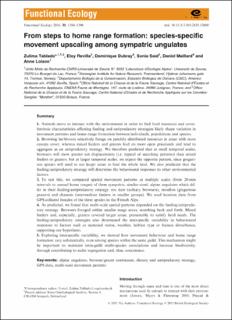| dc.description.abstract | 1.Animals move to interact with the environment in order to find food resources and cover.Intrinsic characteristics affecting feeding and antipredatory strategies likely shape variation inmovement patterns and home range formation between individuals, populations and species.2.Browsing herbivores selectively forage on patchily distributed resources in areas with morecanopy cover, whereas mixed feeders and grazers feed on more open grasslands and tend toaggregate as an antipredatory strategy. We therefore predicted that at small temporal scales,browsers will show greater net displacements (i.e. typical of searching patterns) than mixedfeeders or grazers; but at larger temporal scales, we expect the opposite pattern, since gregari-ous species will need to use larger areas to feed the whole herd. We also predicted that thefeeding/antipredatory strategy will determine the behavioural responses to other environmentalfactors.3.To test this, we compared spatial movement patterns at multiple scales (from 20-minintervals to annual home ranges) of three sympatric, similar-sized, alpine ungulates which dif-fer in their feeding/antipredatory strategy: roe deer (solitary browsers), mouflon (gregariousgrazers) and chamois (intermediate feeders in smaller groups). We used location data fromGPS-collared females of the three species in the French Alps.4.As predicted, we found that multi-scale spatial patterns depended on the feeding/antipreda-tory strategy. Browsers foraged within smaller range areas, searching back and forth. Mixedfeeders and, especially, grazers covered larger areas, presumably to satisfy herd needs. Thefeeding/antipredatory strategies also determined the interspecific variability in behaviouralresponses to factors such as maternal status, weather, habitat type or human disturbance,supporting our hypothesis.5.Exploring interspecific variability, we showed how movement behaviour and home rangeformation vary substantially, even among species within the same guild. This mechanism mightbe important to maintain intra-guild multi-species associations and increase biodiversity,through contributing to niche segregation and, thus, coexistence. | en_US |

